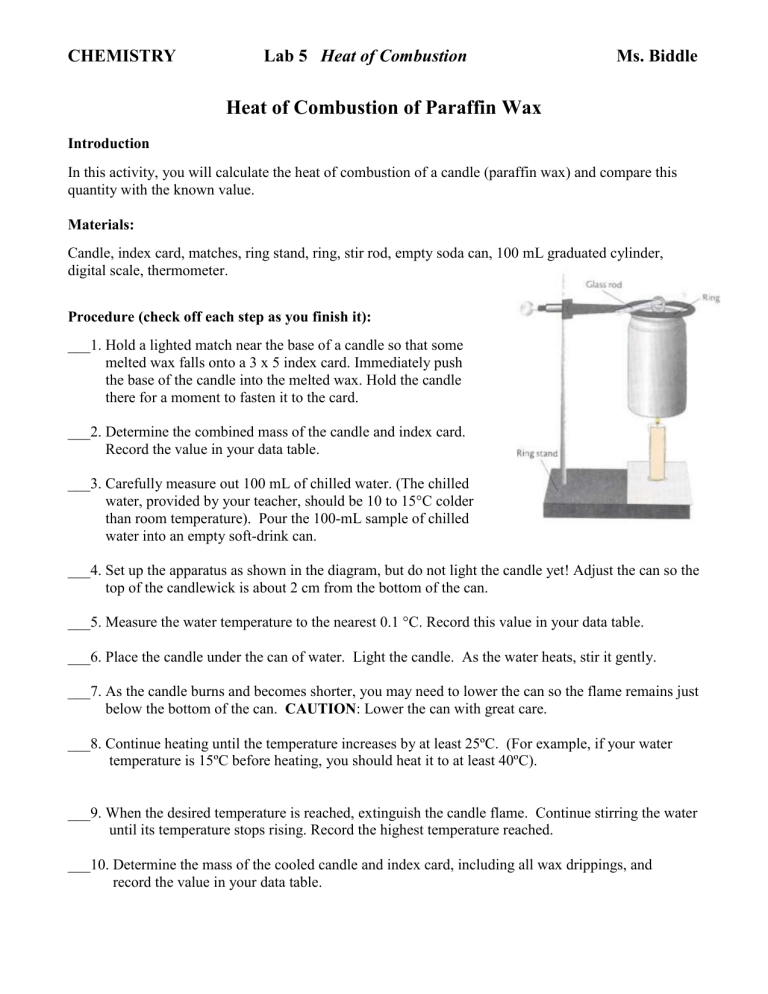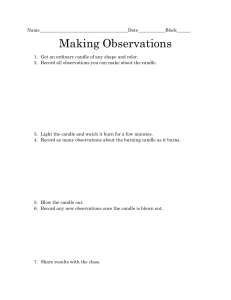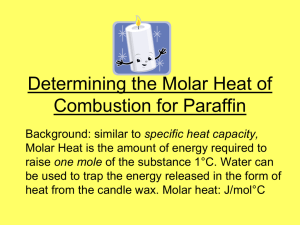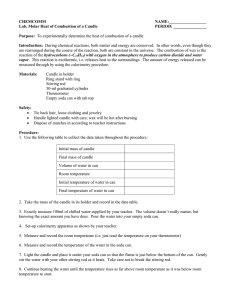Heat of Combustion of Paraffin Wax Lab Report
advertisement

CHEMISTRY Lab 5 Heat of Combustion Ms. Biddle Heat of Combustion of Paraffin Wax Introduction In this activity, you will calculate the heat of combustion of a candle (paraffin wax) and compare this quantity with the known value. Materials: Candle, index card, matches, ring stand, ring, stir rod, empty soda can, 100 mL graduated cylinder, digital scale, thermometer. Procedure (check off each step as you finish it): ___1. Hold a lighted match near the base of a candle so that some melted wax falls onto a 3 x 5 index card. Immediately push the base of the candle into the melted wax. Hold the candle there for a moment to fasten it to the card. ___2. Determine the combined mass of the candle and index card. Record the value in your data table. ___3. Carefully measure out 100 mL of chilled water. (The chilled water, provided by your teacher, should be 10 to 15°C colder than room temperature). Pour the 100-mL sample of chilled water into an empty soft-drink can. ___4. Set up the apparatus as shown in the diagram, but do not light the candle yet! Adjust the can so the top of the candlewick is about 2 cm from the bottom of the can. ___5. Measure the water temperature to the nearest 0.1 °C. Record this value in your data table. ___6. Place the candle under the can of water. Light the candle. As the water heats, stir it gently. ___7. As the candle burns and becomes shorter, you may need to lower the can so the flame remains just below the bottom of the can. CAUTION: Lower the can with great care. ___8. Continue heating until the temperature increases by at least 25ºC. (For example, if your water temperature is 15ºC before heating, you should heat it to at least 40ºC). ___9. When the desired temperature is reached, extinguish the candle flame. Continue stirring the water until its temperature stops rising. Record the highest temperature reached. ___10. Determine the mass of the cooled candle and index card, including all wax drippings, and record the value in your data table. CHEMISTRY Lab 5 Heat of Combustion Name ___________________________________ Ms. Biddle Due Date ___________ Lab Partner(s) __________________________________________________________ Heat of Combustion of Paraffin Wax Measurement Initial mass of candle plus index card Initial water temperature Final water temperature Final mass of candle plus index card Value (with units) - Questions & Calculations: 1. If the density of water = 1.00 g/mL, calculate the mass of water heated (in grams). Recall that density = mass/volume. 2. Calculate the temperature change of the water (∆T). The temperature change is equal to the final temperature minus the initial temperature. 3. Calculate the heat (in joules) absorbed by the water using the formula below. The specific heat capacity of water equals 4.18 J/g ºC. Heat absorbed = (mass of H2O) x (Specific Heat of H2O) x (Temperature Change) q = m x C x ∆T CHEMISTRY Lab 5 Heat of Combustion Ms. Biddle 4. Calculate the mass of paraffin burned in the experiment. This is the difference between the initial mass of the candle and the final mass of the candle. 5. Using the formula below, calculate the paraffin’s heat of combustion in J/gram. 6. Convert the heat of combustion of paraffin into kJ/gram. 1 kilojoule = 1000 joules. 7. The actual heat of combustion of paraffin is approximately 42 kJ/gram. Using this information and your answer to the previous problem, calculate your % error in this experiment. 8. In calculating the heat of combustion, you assumed that all of the heat released from the burning candle was absorbed by the water. a. Is this a good assumption? b. What else may have absorbed some of the heat? Be specific. http://www.arps.org/users/hs/thompsom/chemcom/unit_3/labs/Burning_Candle_Lab.pdf




